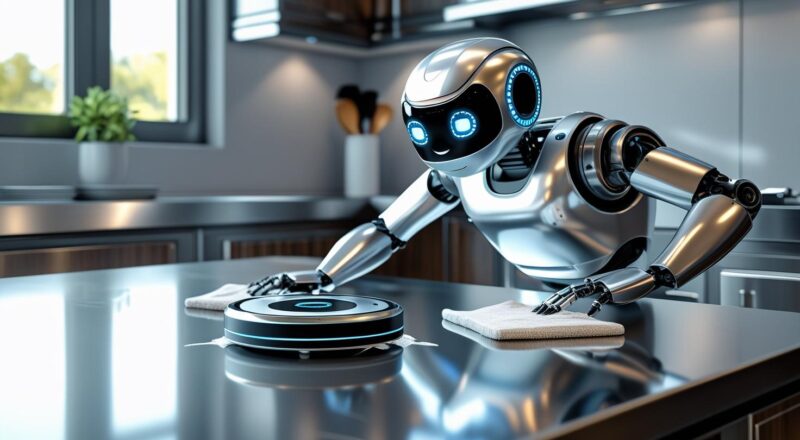For years, the idea of kitchen robots has been relegated to science fiction. While fully autonomous robotic chefs still seem a distant dream, the landscape of kitchen automation is rapidly evolving. We’re not just talking about glorified blenders; sophisticated robotic systems are entering the market, tackling specific culinary challenges and streamlining food preparation in innovative ways. This blog post will explore two recent, concrete applications of kitchen robots that have emerged within the last two years, demonstrating the practical impact these technologies are starting to have.
Automated Gourmet Pizza Production: Precision and Efficiency
Pizza is a globally loved food, but its production, especially at scale, can be labor-intensive and inconsistent. One exciting new application of kitchen robots is in automating the gourmet pizza-making process. Instead of simply spreading sauce on a pre-made crust, these robots handle the entire process, from dough preparation to topping application, with remarkable precision.
Consider the company Picnic, which offers a modular, customizable pizza assembly system. While not a single, human-like robot, it’s a robotic cell designed to integrate seamlessly into existing commercial kitchen setups. This system can automate the precise placement of sauce, cheese, pepperoni, vegetables, and other toppings, significantly reducing human error and ensuring consistent quality. The system uses a combination of computer vision, precision dispensers, and conveyor belts to optimize the pizza-making process. Operators load the prepared dough onto the conveyor, and the system takes over, accurately distributing ingredients according to pre-programmed recipes. The real innovation here isn’t just automation; it’s the ability to customize recipes quickly and easily, allowing restaurants to offer a wider variety of pizzas without increasing labor costs or compromising on quality.
The benefits extend beyond consistency. Automated pizza production can also reduce food waste. The precise dispensers minimize ingredient overflow, and real-time data analysis allows for adjustments to ingredient quantities based on demand, preventing excess preparation and spoilage. This is particularly valuable for businesses striving to improve sustainability and reduce operational costs. The Picnic system is already being used in various commercial settings, from amusement parks to sports stadiums, demonstrating its scalability and adaptability. (Source: Information based on the Picnic company website and industry reports on food automation.)
The adoption of automated pizza production isn’t just about speed and efficiency. It’s about empowering restaurants to focus on creativity and customer service. Chefs can spend more time developing unique recipes and interacting with customers, while the robot handles the repetitive tasks of pizza assembly. This combination of human expertise and robotic precision is paving the way for a new era in the pizza industry.
Robotic Vertical Farming for On-Demand Salad Production
Another exciting development in kitchen robotics lies in the integration of vertical farming with robotic systems to provide on-demand salad production. Indoor vertical farms are already gaining traction as a sustainable and efficient way to grow produce. However, combining this approach with robotics takes it a step further, bringing fresh, locally grown greens directly to the point of consumption.
A company like Infarm, while not entirely new, has dramatically scaled its robotic integration within the last two years. They utilize automated systems to handle tasks such as seeding, transplanting, harvesting, and even packaging. But the innovation goes beyond automating existing farming practices. Infarm’s systems use computer vision and machine learning to monitor plant health and adjust growing conditions in real-time, optimizing yields and reducing waste. The most impactful development is their integration into grocery stores and restaurants, placing modular vertical farms *directly* where the produce is needed.
These “in-store farms” aren’t just aesthetically pleasing; they’re highly functional. Robots are used to harvest the greens on demand, ensuring maximum freshness and minimizing transportation costs and spoilage. Customers can literally watch their salad being harvested just moments before it’s prepared. This transparency and traceability build trust and enhance the overall dining experience. Infarm’s approach also allows for the cultivation of a wide variety of greens, including rare and exotic varieties, that would otherwise be difficult or impossible to obtain locally. (Source: Information based on the Infarm company website and news articles about their expansion.)
Furthermore, the data collected by the robotic systems provides valuable insights into plant growth and optimal farming practices. This information can be used to continuously improve the efficiency and sustainability of the vertical farms, making them an even more attractive option for businesses looking to reduce their environmental footprint and enhance their supply chain resilience. The robotic component significantly reduces the labor costs associated with traditional farming methods, making the in-store farm model economically viable for a wider range of businesses.
The Future of Kitchen Automation
These two examples, automated pizza production and robotic vertical farming, illustrate the diverse applications of kitchen robots emerging today. While we are still far from a fully automated kitchen staffed by humanoid robots, these practical solutions are addressing real-world challenges in the food industry. By combining robotics with advanced technologies like computer vision, machine learning, and data analytics, these systems are improving efficiency, consistency, sustainability, and the overall dining experience.
The continued development and adoption of kitchen robots will undoubtedly transform the food industry in the years to come. As the technology matures and becomes more affordable, we can expect to see even more innovative applications emerge, further blurring the lines between human expertise and robotic precision. The future of food is not about replacing chefs; it’s about empowering them with tools that enhance their creativity and allow them to focus on delivering exceptional culinary experiences.

